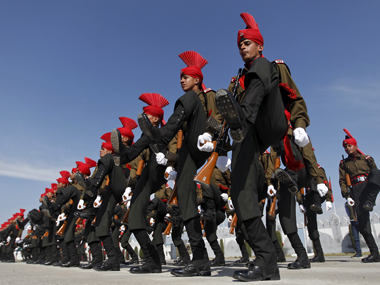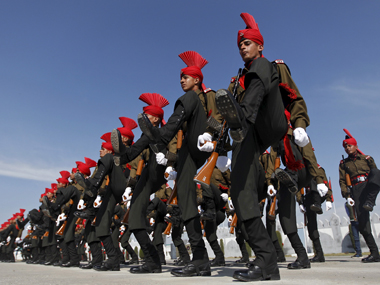Lack of integrated planning for procurement among the armed forces is a huge shortcoming. Merely increasing the defence to GDP ratio will not solve the current predicament.
It’s that time of year when the ministry of finance begins to receive demands for grants from their counterparts, and allocation for defence has always been a point of debate. Despite substantial increase in budget allocation, military spend as a percentage of GDP has been declining in India (see table 1 below). This trend has been the subject of much criticism because India would always have to contend with the possibility of a two-front war scenario with China and Pakistan.
The most commonly proposed solution to this alleged inadequacy in defence budget has been to increase it to around 3 to 4 per cent of GDP. It is believed that this increase will automatically make India’s armed forces redoubtable in terms of military prowess. The truth, however, is that the lack of integrated planning for procurement among the armed forces is a huge shortcoming. No amount of increase in defence to GDP ratio will solve our current predicament.
Table 1: Comparison of India, China and Pakistan’s Defence Budgets
| Year | India’s GDP (USD billion) | Defence Spending as % of GDP | India’s Defence Spending (USD billion) | China’s GDP (USD billion) | Defence Spending as % of GDP | China’s Defence Spending (USD billion) | Pakistan’s GDP (USD billion) | Defence Spending as % of GDP | Pakistan’s Defence Spending (USD billion) |
| 2010 | 1,700 | 2.7 | 46 | 6,000 | 1.9 | 115 | 200 | 3.4 | 0.6 |
| 2011 | 1,800 | 2.7 | 49 | 7,500 | 1.8 | 135 | 200 | 3.3 | 0.7 |
| 2012 | 1,900 | 2.5 | 46 | 8,500 | 1.9 | 161 | 200 | 3.5 | 0.8 |
| 2013 | 1,900 | 2.5 | 47 | 9,500 | 1.9 | 180 | 200 | 3.5 | 0.8 |
| 2014 | 2,000 | 2.5 | 51 | 10,400 | 1.9 | 197 | 200 | 3.5 | 0.9 |
| 2015 | 2,100 | 2.5 | 52 | 10,900 | 2.0 | 217 | 300 | 3.6 | 1 |
Source: World Bank
India also may not be able to afford increases in defence spending, because of a high opportunity cost for money. Short-term solutions such as a defence cess (though how welcome it may be is a point for debate) can raise part of the required capital. The primary education cess, which brought in Rs. 99,352 crore since 2010 alone and the clean energy cess which brought in Rs. 15,174 crore since 2010 are examples of cesses which helped raise revenue for the government. Notwithstanding this, it is still wrong to compare India’s defence budget to that of China or for that matter Pakistan. It is quite obvious that China’s defence spending will be higher because China’s GDP is much larger. China’s strategic areas of interest or potential conflict areas, namely the Tibet Autonomous Region, Taiwan, Xinjiang and South China Sea (not including its posturing in India’s NER) necessitates their large defence budget. Meanwhile Pakistan’s absolute GDP is much smaller than India’s and its history of military rule means that their defence budget forms a higher percentage of their GDP. These factors are crucial in understanding that percentage of GDP is not an effective indicator of the adequacy of defence budget especially in the wake of systemic inefficiencies in allocation. Total budget allocation is a better indicator of the military might and efficiency of a nation, and therein lies our first problem.
In India, our allocations are slanted disproportionately towards salaries, pay allowances and pensions (revenue expenditure) rather than towards modernisation or capital acquisitions (capital expenditure), an almost consistent ratio of 1.5 times, courtesy of the Indian army. (It must be noted here that this is due in large part to the numbers that the Army employs.) On further examination it is found that for the army, the ratio of revenue to capex is 80:20. The navy and the air force have been able to manage capex better because their planning has been focused and phased.
When the ministry of finance allocates money, it is for the ministry of defence and the three services to share amongst themselves in their acquisitions and annual plans; rarely in equal proportions. Therefore any increase in budget allocation is not going be divided uniformly across services, particularly for capex. This is primarily because an increase in the capex of one service comes at the cost of the other two. That is, if one service receives a higher allocation for capex, the other two will receive lower allocations.
Allocations for capital acquisitions are a subset of total capex. The allocation for capital acquisitions is further sub-divided under the heads of ‘committed liabilities’ and ‘new schemes’. Committed liabilities are payments anticipated for a financial year with regard to contracts concluded in previous years or to be finalised in that fiscal. These hold first charge in budget allocations as an inadequate allocation under this head could lead to defaults on contractual obligations. Therefore, quite naturally, the amount allocated under this head is much higher than ‘new schemes’ (Table 2).
Table 2: Committed Liabilities and New Schemes
| Year | Service | Capital Acquisition | |
| Committed Liabilities | New Schemes | ||
| 2014-15 | Army | 18,851.26 | 2,084.15 |
| Navy | 21,248.07 | 663.92 | |
| Air Force | 29,173.40 | 2,644.99 | |
| 2015-16 | Army | 20,513.44 | 1,541.06 |
| Navy | 22,248.12 | 1,112.78 | |
| Air Force | 28,246.53 | 3,264.09 | |
| 2016-17 | Army | 19,449.26 | 2,086 |
| Navy | 18,763.77 | 1,600 | |
| Air Force | 22,871.05 | 4,684.97 | |
Source: 22nd Report of the Standing Committee on Defence
The air force’s committed liability has come down in 2016-17 on account of closure of the Rafale deal. Similarly for the navy because of the acquisition of the Scorpene submarines. In the case of the army however, we see a systematic increase in committed liabilities and no discernible increase in new schemes. Meanwhile, capex has declined for the army.
The reason for the decrease in capex and the concomitant increase in committed liabilities is because payments that should have been made to close contracts have not been made due to delays. Ordnance Factories, which are the main suppliers of equipment to the Army, are to blame. The delays in certain important projects by OFs have been between 3 and 5 years. Therefore any increase in budget allocation will end up only being a committed liability, never to be disbursed. The opportunity cost for this money is very high because it can be put to better use by the navy, air force or any other sector of the economy.
It is not that the navy and air force are completely guilt-free. Though it is true that capital expenditure usually gets adjusted between the three services, there is enough evidence to suggest gross under-utilisation of capital acquisition budgets (Table 3), even though, “under-spending by one service is usually counter balanced by excess spending by another service.” This reinforces the fact that extra money, which is available, is not being used for capital acquisition.
Table 3: Underspending of Capital Acquisition Budget
| Year | Budget Estimate (in Rs. crore) | Actual (in Rs. crore) | Underspending (in Rs. crore) | Percentage of Underspending |
| 2012-13 | 66,032 | 58,769 | 7,263 | 11 |
| 2013-14 | 73,445 | 66,850 | 6,594 | 9 |
| 2014-15 | 75,148 | 65,582 | 9,566 | 13 |
| 2015-16 | 77,407 | 65,742 | 11,665 | 15 |
Source: 22nd Report of the Standing Committee on Defence
The answer obviously does not lie in increasing the overall defence budget, but in the MoD and the services stepping up their integrated planning and efficient utilisation of budget allocations. They would also benefit from ensuring that contracts that have been committed to, run on time. Cess or no cess, 2.26 per cent of GDP or 3 per cent, $52 billion spent on defence or $217 billion, are all irrelevant when nobody seems to know where to spend the money. The money may as well be saved to reduce India’s fiscal deficit.
Nirupama Soundararajan is a Senior Fellow and Dnyanada Palkar is Senior Research Associate at Pahle India Foundation.

